Guide to Building Redundant and Diverse Internet Connectivity
In this article, we’re going to show you how to construct a high availability network by utilizing redundant and diverse routing in your network design.

Jan 25, 2023
SHARE
The narrative is changing. The world seems to have gone from, “How do we stop climate change?” to the more realistic, “How can we adapt to survive the extreme weather events brought by climate change?”
We’ve discussed how businesses can approach this problem in other blogs, most notably Matt Pinto’s piece on “Leveraging Disaster Recovery/Business Continuity,” which explored how businesses can best prepare for these inevitable challenges.
Disaster Recovery vs. Business Continuity
In brief, that article covers two thought streams.
Should the worst happen, would it be sensible to step back from your day-to-day activities? If so, you’ll need a disaster recovery plan so you can return to business afterwards with minimum disruption.
On the other hand, would shutting down your activities create bigger problems (beyond the obvious loss of revenue) – either for your customers or for your business?
If so, you’ll need a business continuity plan to remain operational for as long as possible in the face of adversity.
If your activities fall into option 2, then it’s likely that internet connectivity uptime will be a key priority in your business continuity plan.
In this article, we’re going to show you how to plan for business continuity – even in the worst of times – by including redundant internet and diverse routing in your planning.
Why Does Redundancy and Diversity matter?
Simply put, internet access downtime is very costly for most businesses. According to a Gartner study, IT downtime can cost businesses north of $5,600 per minute. Yes, you read that right.
Although that headline number may initially seem surprisingly high, when you factor in potential lost revenue (if you’re a shipping business, IT downtime means you’re not shipping packages!), opportunity cost of reduced productivity (workers can’t get work done), and any costs of getting things back up, the headline number begins to make more sense.
The cost and risk of downtime will of course differ from business to business, but there is almost no business out there where downtime isn’t costly. With that in mind, taking time to evaluate redundant and diverse networking options for your business and paying a little more to ensure your risk of downtime is exponentially lower likely makes economic sense.
So what does “redundant” or “diverse” mean in the context of connectivity anyway?
Redundant vs. Diverse
Redundancy and diversity describe very different (and valuable) characteristics of a resilient network. Let’s define these terms in an engineering context.
Redundant: (adjective) serving as a duplicate for preventing failure of an entire system upon failure of a single component.
Diverse: (adjective) composed of distinct or unlike elements or qualities.
Now, let’s place those clear definitions in the context of internet circuit procurement, to help you figure out how to incorporate them into your business continuity plan.
Redundant internet: more than one path to the internet
Diverse internet routing: the paths to the internet are different
To build a truly resilient network, you’re going to need both attributes.
How To Build Redundant Internet Paths
When you’re looking to create redundant internet, there are best practices that can be adopted – the same methodologies carrier networks use to ensure their provision is robust will serve equally well for enterprise business communication builds, too.
N-modular redundancy is the commonly accepted lingo used to describe various levels and types of redundant internet circuitry (as well as more generalized systems planning). While it may look like yet another example of IT jibber-jabber, it’s a neat shorthand that makes things much clearer and easier to understand.
It looks a little like algebra, but the three main concepts – minimum functional system, additional backup, and additional independent system – are easily identified.
N = the bare minimum required for the system to function
N+1 = the addition of a backup system to N (“backup” defined here as non-functional, unless there’s an emergency)
N+(X) = the addition of multiple backup systems, with several backups represented by X
2N = two fully capable independent systems
2N+(X) = two fully capable systems, each with several backup systems
XN+(X) = represents the idea of ongoing expansion of your redundancy plans
Likely, budget limitations will dictate the amount of redundancy you incorporate into your systems (long before you run out of supply options).
It would be wise to carefully weigh the financial cost of each layer of redundancy against how much real-world flexibility that additional layer will bring, in the event of a disaster or extreme situation. Beyond a certain level, the probability that a redundancy layer will ever be used diminishes.
N-Modular Redundant Internet Path Examples
So, what do these different N-modular redundant internet paths look like as circuits? Here are some diagrammatic examples of the redundancy formulae we introduced above.
N = internet from a single service provider, via a single router.
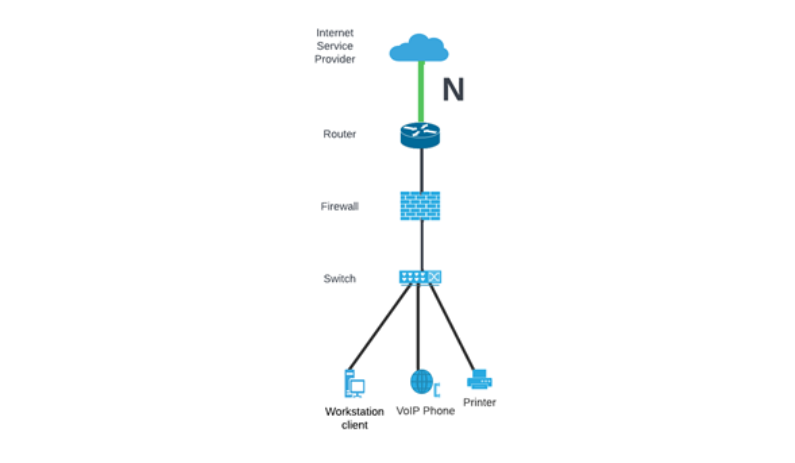
N+1 = the same circuit but with a backup circuit (notice that the backup follows the same route, with the same service provider and router equipment).
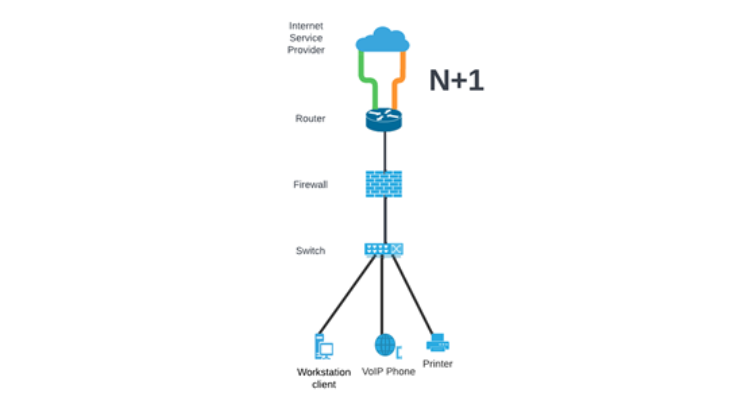
2N = two separate circuits, with two redundant internet service providers and two redundant routers.
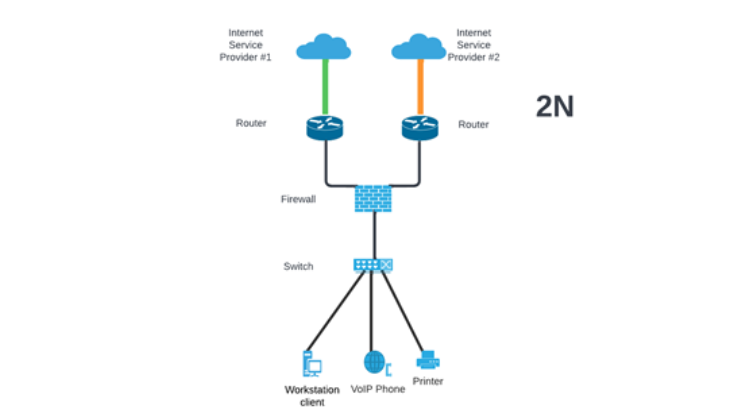
Notice that in the 2N example above, redundancy ends at the organization’s firewall – so both circuits are forced to use the same path through the local area network (LAN).
This doesn’t have to be the case, though – it’s possible to procure redundant internet circuitry all the way to the endpoint, depending on your budget and your organizational needs. Here’s what that looks like.
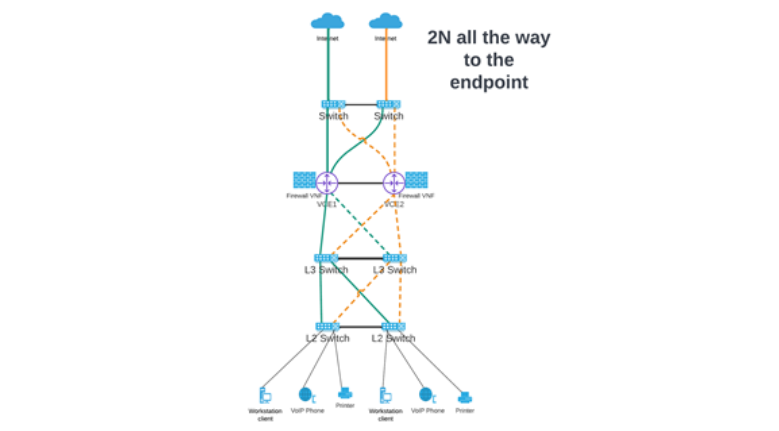
However, if you’re planning to extend your redundant circuits in this way, it’s important to thoroughly research your ISPs, and find out exactly what’s happening upstream.
Picking the Right ISP for Your Redundant Internet
We recently explored the differences between Tier 1, Tier 2, and Tier 3 internet service providers, and how to decide which tier works best for your business.
Understanding how the different tiers operate is useful when procuring an effective redundant internet solution.
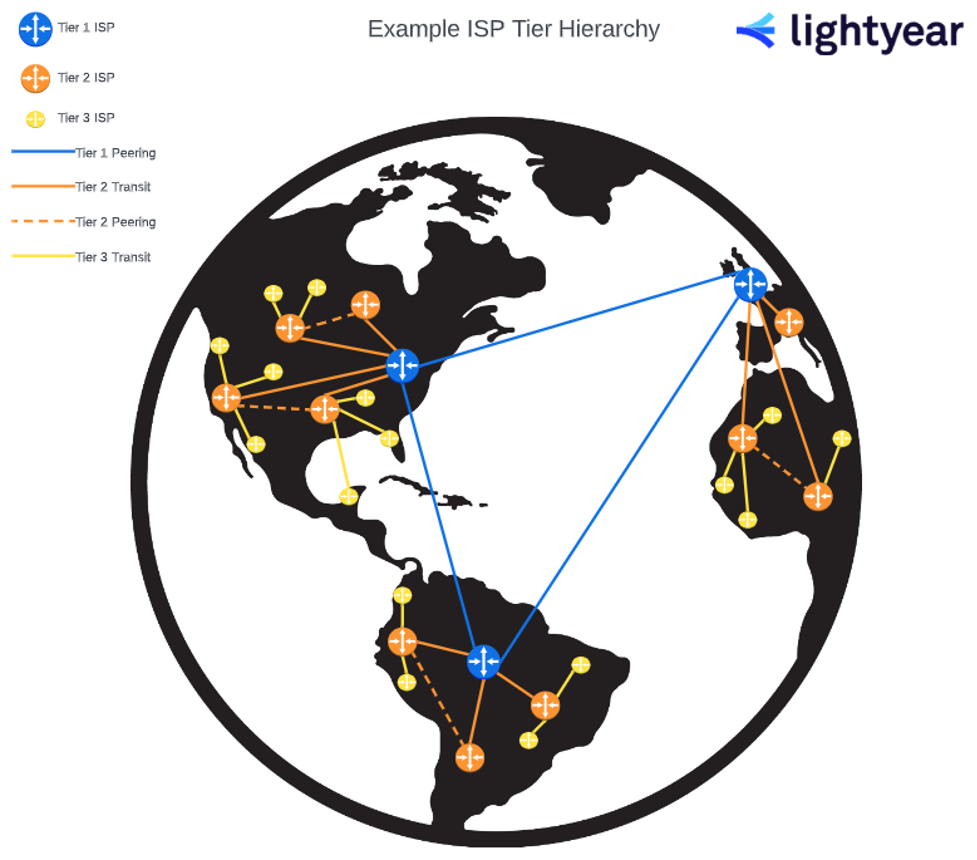
A Tier 1 ISP (which owns the physical network of your entire region) is unlikely to give you any surprises when your circuit meets the LAN.
If you’re with AT&T, for example, it’s more than likely that AT&T will be your carrier in the last mile, and the middle mile, too.
However, if a Tier 3 ISP (who is basically renting lines from Tier 1 and Tier 2 ISPs) provides your redundant internet circuit, then you’ll have to do some snooping. Because if Tier 3 is running its LAN on AT&T infrastructure, then your redundant internet isn’t redundant at all. If AT&T goes down, so does your redundant circuit.
If you’re planning on using Tier 3 ISPs in your business continuity plan, be prepared to ask a lot of questions (and get some complicated answers). You’ll need to find out who’s providing the circuits right across the LAN.
Alternatively, you could ask Lightyear – our telecoms procurement platform has been designed for this purpose and will help you identify the ISPs whose setup serves your needs.
These potential issues across your LAN highlight the importance of diversity in your continuity planning.
Diverse Routing Is Crucial to Your Business Disaster Response
As we’ve just explained, a redundant internet circuit isn’t always diverse. And (to use the N-modular parlance), it doesn’t matter if you’ve got 2N, 3N, 4N… if the same carrier provides all those circuits, then you’ve only got as much reliability as that one carrier can provide.
Your approach to planning diverse routing needs to be methodical, following the route path as much as possible, starting from your building’s phone closet or server room.
Again, we’ve pulled some visual resources together (based on real-life use cases) to help explain the concepts we’re discussing.
This site plan is a great example of what internet circuit diversity should look like at the site end.
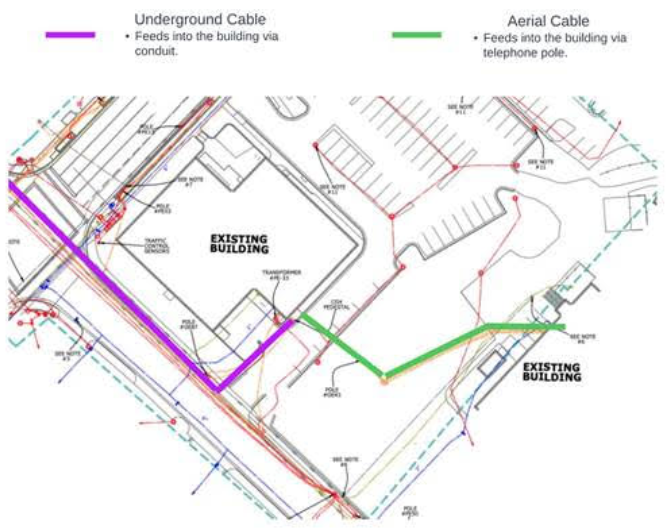
In green, we can see the aerial cable that feeds into the building via telephone poles from the east.
In purple, there’s an underground cable that feeds into the building from the west via a buried conduit between the telephone equipment room and the nearby utility easement.
For maximum diversity of routing, the paths don’t intersect at any point before the telephone closet. And the additional physical diversity (one overground, one underground, coming from different parts of the site) adds an extra layer of protection in case there are problems in the immediate vicinity.
So, assuming you’ve achieved diverse routing for your redundant internet circuits at the site entry point, what should you check now?
You’ll need to verify diversity along the “last mile,” between your site and the ISP’s point-of-presence (POP).
Reach out to your ISP to fully investigate this. You’ll need to allow them time to respond, but they’ll usually get back to you within a few working days to provide the route path data. This is usually presented in .kmz formatted data – if you’re not familiar, .kmz is a file type like a .zip file. Google created it to share map locations and geographical information.
Let’s look at some of this data, to see how it helps us identify opportunities for more diverse routing.
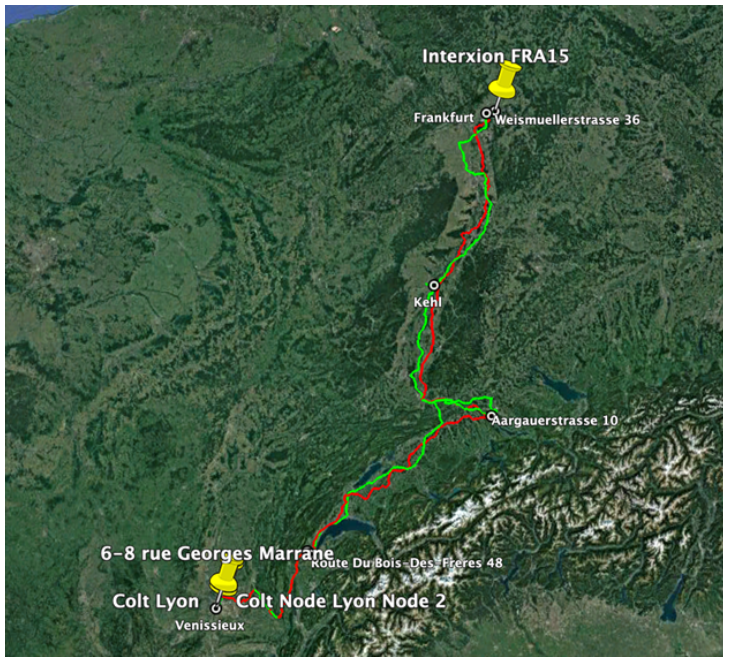
In this real-life example, both of the “Colt Lyon” circuits were designed to connect to the “Interxion” data center. However, when the provider delivered the .kmz file, it was quickly evident that these redundant internet carrier paths were using the same network for large sections of their journey. From a diverse routing perspective, this didn’t work well at all.
To obtain diversity, it was necessary to enlist the help of a third provider. This new partner offered a fresh route path. The new route path also terminated at a different data center (“Equinix”) near Paris, which served to further increase the diversity of the redundant internet circuits.
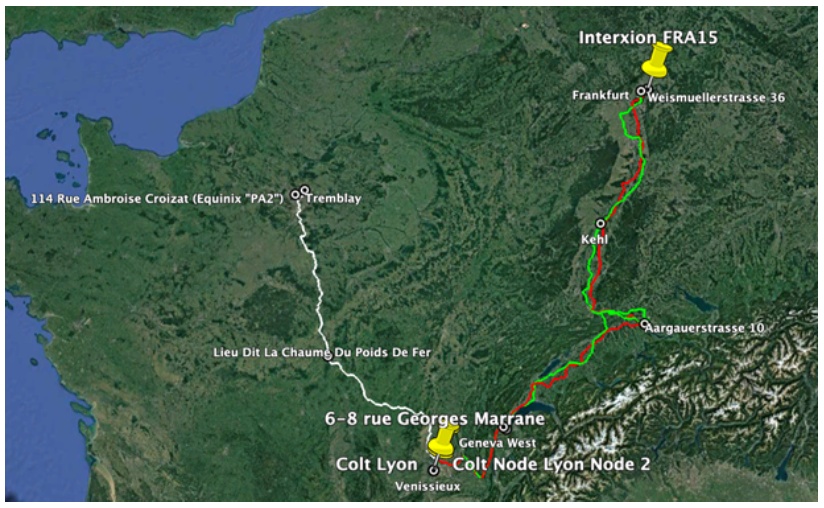
As you can see from these two examples, there’s a myriad of variables at play when trying to design diverse redundant internet circuits. There are factors that affect everyone, such as geographic location, access to infrastructure, and ISP provider proximity.
But there are also the requirements of your organization to consider. Each business continuity plan is different. These plans need regular review, too, as the needs of both the business and the customer base evolve.
And as we’ve seen, the environment in which we make our plans is no longer something we can take for granted.
If you’d like to take the guesswork out of your redundant internet procurement, we recommend you try us out at Lightyear. The extensive industry knowledge and experience that underpins our automated procurement platform will allow you to quickly find the connectivity solution that suits your business best.
Want to learn more about how Lightyear can help you?
Let us show you the product and discuss specifics on how it might be helpful.
Not ready to buy?
Stay up to date on our product, straight to your inbox every month.
